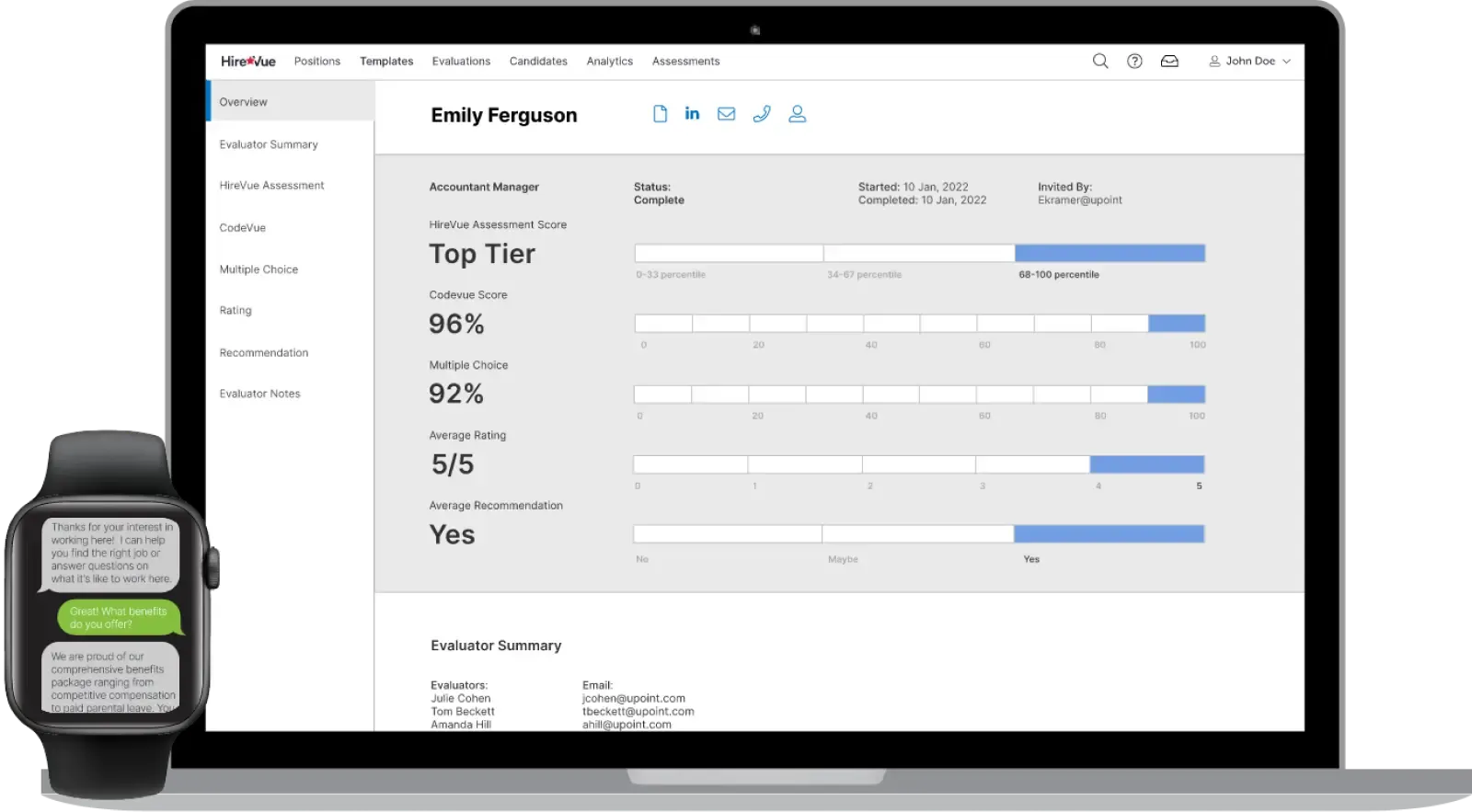Services
SERVICES
SOLUTIONS
TECHNOLOGIES
Industries
Insights
TRENDING TOPICS
INDUSTRY-RELATED TOPICS
OUR EXPERTS

June 24, 2025
Staff shortage or overstaffing can negatively impact operational efficiency and disrupt key business workflows. HR teams use data analytics solutions with AI capabilities to prevent such outcomes by identifying potential skill gaps, predicting workforce supply and demand, and thus accurately planning hiring initiatives to meet future talent needs.
Major HR-oriented online platforms, such as LinkedIn, feature ML-based recommendation systems that efficiently segment, rank, and suggest potential candidates for an open position based on their experience and skill set, making recruiting faster and cheaper. Headhunters can also leverage generative AI capabilities to quickly create comprehensive descriptions for their job postings.
HR departments can use AI agents and NLP-powered bots at various stages of the onboarding process to improve new employee engagement and recruiting experience. For instance, chatbots can provide new hires with credentials and answer their questions 24/7.
AI-powered solutions help companies monitor employee workload for effective shift scheduling and provide personalized benefits, like health insurance options or retirement plans. Such tools also enable HR specialists to analyze the turnover rate and optimize talent retention and churn prevention strategies accordingly. This results in a more pleasant work environment and superior employee satisfaction.
Companies can use AI-driven adaptive learning solutions to plan and execute tailored professional paths and training initiatives (including the use of personalized eLearning content, employee handbooks, and other resources) based on each employee’s current capabilities and skill gaps. This helps foster career progression and internal mobility and prioritize talent redeployment over layoffs.
With the help of HR data analytics software powered by AI, HR teams can monitor workforce KPIs to assign roles and responsibilities based on actual performance, support underperformers with targeted coaching initiatives, and reward the best employees with bonuses. These tools can also help identify key performance drivers, such as specific training programs or incentive schemes.
Thanks to the AI-based analysis of business outcomes and workforce performance data, organizations can assess the cost-effectiveness of their HR initiatives to prioritize the most beneficial ones. For example, HR managers can evaluate the results of mentoring and upskilling programs to decide whether to hire new specialists or retrain existing employees for new positions. They can also plan future salaries and bonuses to maximize talent retention while staying within budget constraints.
HR departments can implement an ensemble of AI-related tools and technologies tailored to their organizations’ specific goals, requirements, and business scenarios.
Predictive analytics solutions rely on statistical and machine learning models to forecast future trends or business outcomes and provide recommendations on the best course of action.
Thanks to their high degree of autonomy and advanced problem-solving capabilities, AI agents can handle multi-step business processes with maximum accuracy and minimal human intervention.
GenAI-powered software uses natural language processing to understand user instructions or 'prompts' and quickly generate text, code, visuals, or other types of original content.
Predicting employee churn based on engagement survey results
Automating key recruiting tasks, from screening applications to scheduling interviews
Creating job descriptions or training materials
Scheme title: AI in HR market size forecast
Data source: Precedence Research
| 26% of organizations surveyed use AI to support HR activities. Of these, 62% have only started using AI in the last year. The IT industry is the leading sector in terms of AI adoption in HR (35% of organizations), followed by finance and insurance (32%). | |
|---|---|
| Up to 85% of HR leaders surveyed said they are ready to lead teams that use AI solutions. | |
| 11% of HR leaders said they have already implemented generative AI, while 9% are planning to implement it. An additional 18% is conducting generative AI pilots and proofs of concept. | |
| Companies in the media and telecom industry are the major adopters of GenAI technology in HR (22%), followed by professional services firms (17%) and tech companies (16%). |
Scheme title: Most popular AI use cases in human resources
Data source: SHRM
*Question was select all that apply. Among those who indicated their organization uses Al to support HR-related
activities
| Most companies relying on AI for recruiting use it to generate job descriptions (65%), while organizations implementing this technology for learning and development apply it primarily to provide employees with personalized training opportunities (49%). When it comes to performance management, the most common AI use case is providing employees with more comprehensive performance feedback (57%). | |
|---|---|
| According to HR leaders surveyed, the highest priority GenAI use case is document generation (53%), followed by job description generation for recruiting (52%) and employee-facing chatbots (51%). |
| 88% of companies leveraging AI for recruitment and hiring processes use it to save time and increase efficiency. Meanwhile, 51% of organizations implementing this technology for learning and development aim to make their programs more effective. | |
|---|---|
| 3 out of 4 HR professionals believe that advances in artificial intelligence will increase the importance of human intelligence in the workplace over the next five years. | |
| 24% of respondents whose organizations use generative AI in their HR business units reported a cost reduction of more than 10%. | |
| Thanks to generative AI, HR staff will spend 60% to 70% less time on administrative tasks. |
| The top reasons why companies don’t use AI in HR include difficulty identifying the right AI tools for their needs (42%), lack of resources to audit and correct algorithms (41%), and a perceived lack of human touch (40%). | |
|---|---|
| The most common challenges companies face when using AI in HR include concerns over data privacy and security (40%), employee resistance or lack of trust (21%), and lack of resources to monitor and fine-tune algorithms (17%). | |
| 34% of HR professionals report using ChatGPT or other GenAI tools at work, suggesting that some of them may use this technology without oversight from their organization (so-called shadow AI). | |
| 67% of the organizations surveyed have no AI governance model at all, while 27% have one but it's not HR-specific. |
hours of data gathering and entry in one quarter
IBM adopted an AI-powered automation system called HiRo to help its HR staff perform a variety of time-consuming tasks. For instance, it can collect and analyze data to compile lists of employees eligible for promotion.
in response times to HR queries
A multinational bank partnered with Deloitte to complement its service desk agents with an AI-powered smart assistant. The chatbot can handle common HR help desk queries and even improve its capabilities by observing human interactions between employees.
time spent to process sick leave submissions
Covestro, one of the world's leading suppliers of polymers, opted for an AI-enhanced RPA solution by UiPath to automate its HR processes. The solution uses OCR and ML to extract data from sick leave documents and enter it into corporate systems.
Talenteer is an AI-based internal talent marketplace developed by Itransition to improve the transparency of open positions and facilitate employee redeployment while minimizing staff turnover and external over-hiring. The solution acts as a single point of truth, centralizing employee data (roles, expertise, etc.) and helping HR managers track in-house experts across the internal talent pool based on a set of given parameters.

Recruiter is a hiring platform by LinkedIn featuring a talent search and recommendation system powered by ML algorithms. This HR solution can compile lists of candidates matching a search request or job posting and rank them based on their expertise, current location, and other factors. It also considers the mutual interest between candidates and recruiters (for instance, if the former positively reply to HR managers' InMail messages).
Scheme title: LinkedIn Recruiter’s operation
Data source: LinkedIn
Eightfold AI is a deep learning-powered talent intelligence platform covering recruitment processes, upskilling, employee retention, and workforce diversity. This tool automates resume screening and minimizes bias via profile data masking. It can also aggregate employee data and leverage AI to match staff members with the most suitable internal jobs, projects, career paths, and development opportunities based on their performance.

HireVue is a talent experience platform focusing on recruitment at scale through AI-based video interviewing. The system provides candidates with a list of questions to be answered autonomously via video. Then, it transcribes the answers and issues a score based on the use of keywords, tone of voice, and other parameters, combined with a game-based test and a technical skills assessment to rank the applicants.

Image title: HireVue’s interface
Image source: hirevue.com — Professional hiring software
Phenom AI is a comprehensive tool leveraging ML to enhance talent acquisition, employee development, and HR administration. The platform can automate routine tasks, such as candidate screening and scheduling, and provide job seekers with recommendations tailored to their interests and browsing history. It also relies on data analytics to help hiring managers identify suitable candidates based on an AI-generated fit score.

achieved through the automation of time-consuming tasks, such as content creation and benefits management using generative AI, chatbots, and AI agents.
thanks to targeted upskilling programs and motivational incentives and rewards based on KPIs.
through AI-enabled predictions and proactive recruiting and retention programs to prevent churn, understaffing, and other disrupting outcomes.
secured by minimizing administrative overhead through automation and avoiding additional recruiting expenses due to lowered employee turnover.
thanks to seamless onboarding via chatbots and data-driven, bias-free decisions on benefits and career progression.
Organizations willing to enhance their HR processes with AI should address various implementation considerations. Keep in mind these recommended best practices.
Challenges | Recommendations | |
|---|---|---|
Data availability |
Given the highly data-driven nature of AI, any HR solution leveraging this technology for analytical or
operational purposes should be fueled with historical data and ongoing streams of real-time information.
|
|
AI model reliability |
While artificial intelligence can certainly foster data-driven decision-making, AI models aren’t 100%
accurate and can still suffer from bias. For instance, some recruiting engines have been shown to
disadvantage female candidates in the past.
|
|
Security & compliance |
AI-based HR software solutions typically handle a fair amount of sensitive data, including employees'
personal information and financial reports. This makes them ideal targets for hacking, breaches, or leaks.
Integrations with other systems multiply the potential points of vulnerability, aggravating cybersecurity
and compliance issues.
|
|

Rely on our expert consultants to plan and supervise your AI project, overcome technical roadblocks, and maximize the adoption payoffs of your new AI solution.
Team up with our developers to build AI solutions tailored to your needs or modernize existing software in line with new tech trends and business requirements.

Often regarded as a depersonalizing force, artificial intelligence in HR has proven capable of amplifying the most exquisitely human facets of our jobs and workplaces. AI-powered solutions can help organizations ensure a fair career progression, improve employee engagement, create positive working environments, and ease HR managers' administrative burden.
At the same time, the architectural complexity, data voracity, and “black box” nature of these systems call for prudent and reasoned implementation. Consider relying on Itransition to maximize the benefits of AI for HR and overcome the challenges of its adoption.
AI adoption across key HR functions is likely to expand in the future, as predicted by multiple case studies, such as HR’s Future State Report by Eightfold AI. Popular use cases will include upskilling and reskilling, workforce equity and inclusion, turnover and retention, talent acquisition, talent redeployment, and diversity in hiring. Furthermore, McKinsey highlighted the growing role of generative AI in writing job descriptions and requirements, powering chatbots, and preparing performance reviews.
McKinsey pointed out that while AI tools may not completely replace HR managers, they are likely to reshape their job. If supported with proper retraining initiatives, HR professionals will progressively shift from administrative duties to employee-facing roles and supervision tasks (the so-called "human-in-the-loop" model).

Insights
Explore the role of AI in the workplace, its use cases, and future trends, along with adoption benefits and guidelines for overcoming potential roadblocks.

Service
Itransition delivers HR software solutions to help companies eliminate administrative burden, maintain regulatory compliance, and improve employee engagement.

Case study
Learn how we implemented a tailored talent marketplace platform Talenteer, optimizing the staffing process in a software testing company.

Case study
Learn how Itransition developed an RPA bot that automates addition of new candidates to the HRM, significantly increasing process efficiency and reliability.
Services
Industries